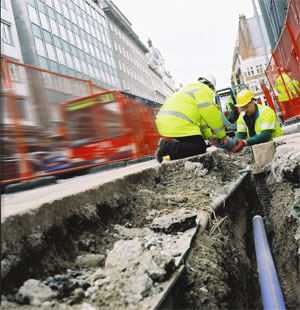The European Drinking Water Directive of 1998 tightened overall standards for drinking water in Europe. As a result, steps have been taken in England and Wales to reduce lead concentrations and mitigate lead poisoning in drinking water.
Lead in drinking water can cause a variety of adverse health effects. In babies and children, exposure to lead in drinking water above the action level can result in delays in physical and mental development, along with slight deficits in attention span and learning abilities. In adults, it can cause increases in blood pressure. Adults who drink this water over many years could develop kidney problems or high blood pressure.
Lead pipes were used in the UK up to the 1980s both for connecting a property to the water supply main and for internal plumbing, due to lead’s strength, malleable nature and resistance to corrosion. In the UK, about 40% of properties are supplied via a lead pipe. Elsewhere in Europe, the estimated percentage of properties supplied by lead pipe-work varies from 5% to 50%.
Although the rate of corrosion of the internal lead pipe wall is very small, lead dissolution into drinking water can very occasionally still reach concentrations of several milligrams per litre (parts per million), way in excess of the concentrations considered to be safe for regular ingestion (parts per billion). Lead pipes are, by far, the commonest source of lead in drinking water.
Since December 2003, a standard of 25 µg/l has been applied to the point of use by the consumer (commonly regarded as the kitchen sink tap). In 2013, the standard in the UK will tighten to 10 µg/l.
Two methods are currently being employed to reduce lead in drinking water in England and Wales.
- Replacement of lead pipes. This process has been underway for more than a decade in the UK. Despite the huge costs and inconvenience, replacement of ALL lead pipes is the long-term goal, although this goal is complicated by practical considerations of location and ownership. Lead pipes are partly owned by the water supplier and partly owned by the property owner.
Currently a widespread replacement program has begun in London and across England and Wales, not only due to lead contamination, but also for leakage. Most of England and Wales water and sewer system dates back to the Victorian Age and leakage of these 150+ year old pipes is a significant problem. We will examine these replacement endeavors in future posts. - Reducing the plumbosolvency of water supplies (how readily they dissolve lead) by dosing with a corrosion inhibitor (most commonly ortho phosphate). This method, also employed in the United States, can offer a rapid, comprehensive and low-cost approach for reduce lead contamination. Water supplies on the East Coast, especially around Washington DC and Arlington, Virginia, are being treated with ortho phosphate to dissolve lead, but the process is not without controversy.
In future posts we will also explore more on the dangers of lead in the drinking water in the UK, the United States and elsewhere.











![Washington State Water Quality Assessment [303(d)] Washington State Department of Ecology](http://www.rosemerena.org/home/wp-content/uploads/2009/03/ecy_logo.gif)

